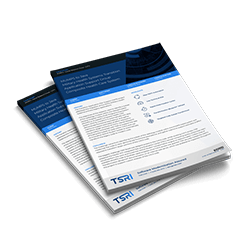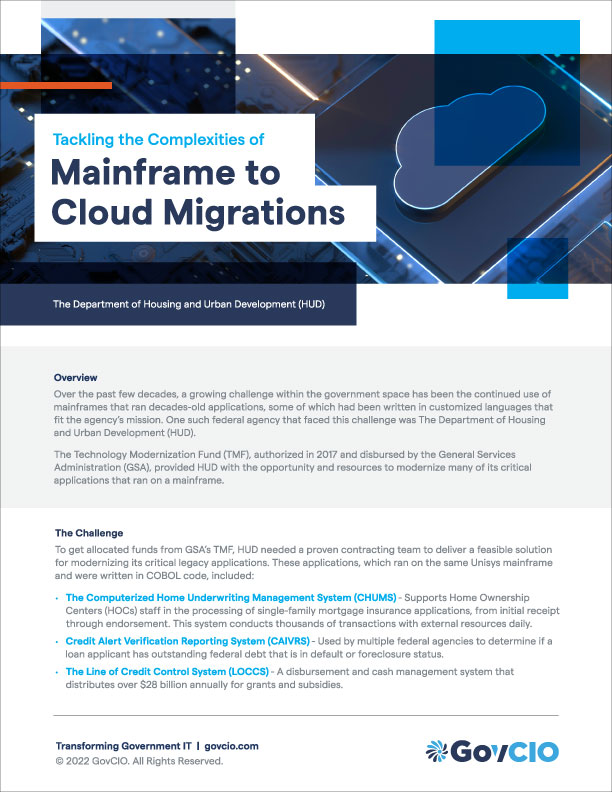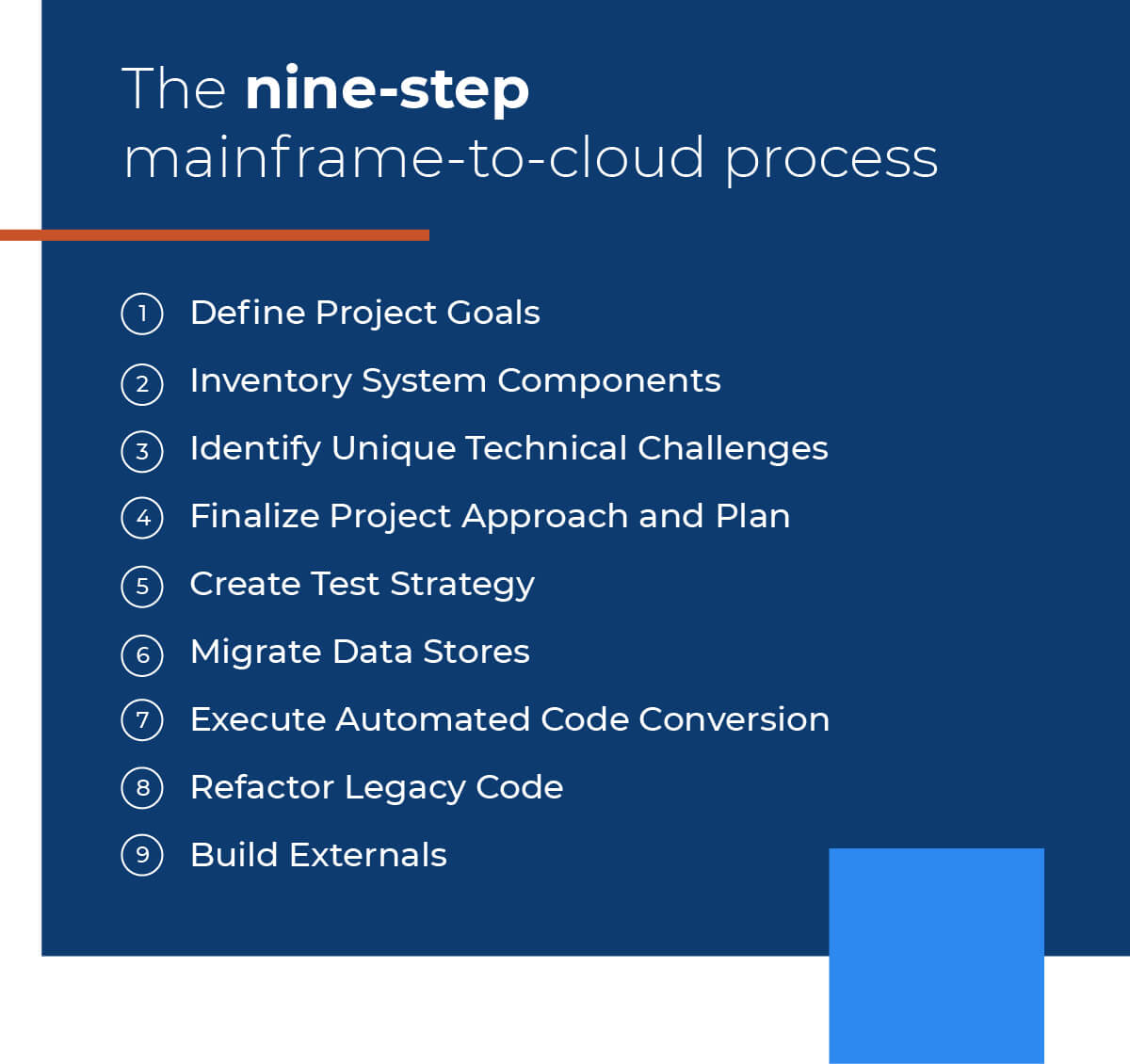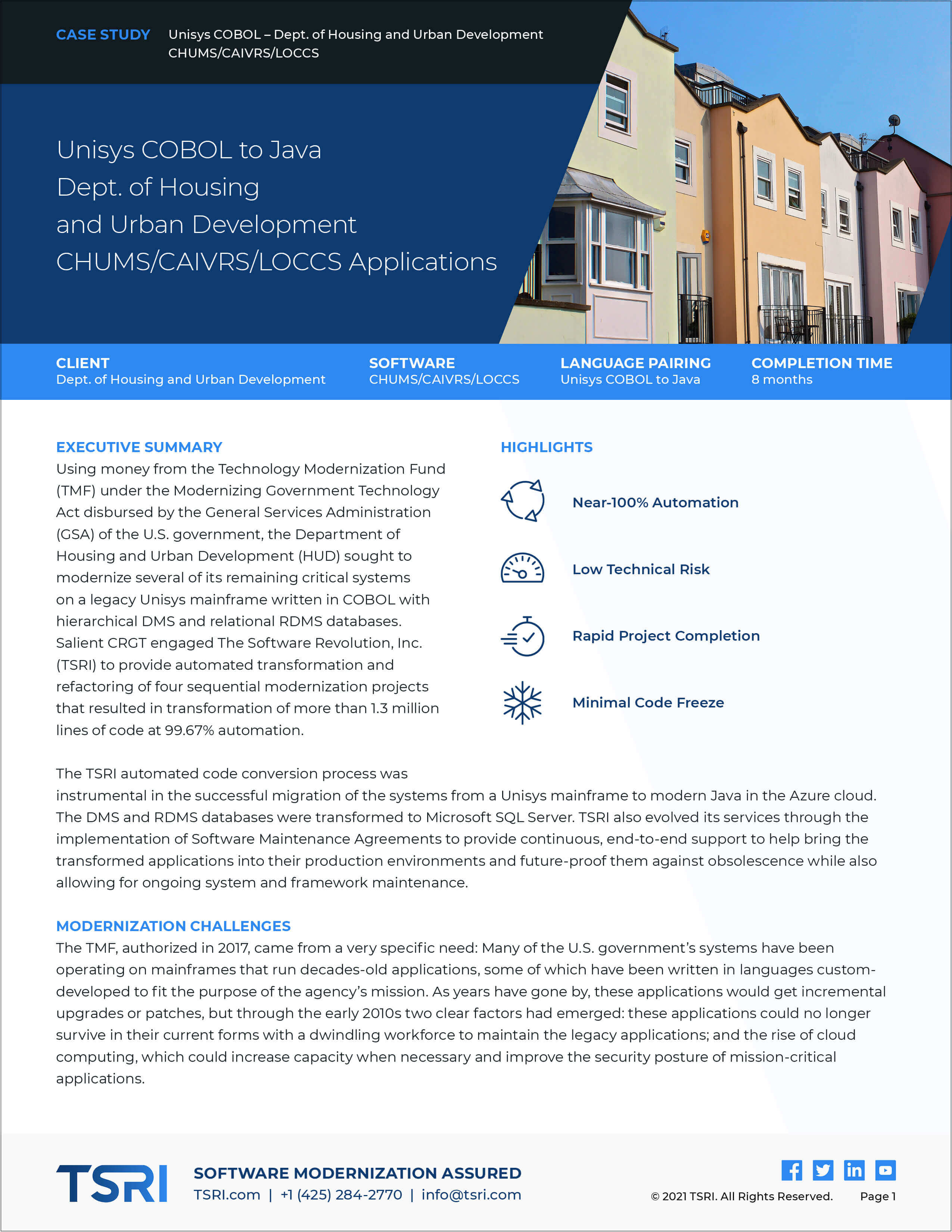Displaying items by tag: HUD
Housing & Urban Development (HUD) - COBOL to Java CHUMS, LOCCS, F42d/CAIVRS Modernization
Using money from the Technology Modernization Fund (TMF) under the Modernizing Government Technology Act disbursed by the General Services Administration (GSA) of the U.S. government, the Department of Housing and Urban Development (HUD) sought to modernize several of its remaining critical systems on a legacy Unisys mainframe written in COBOL with a flat-file DMS-II database.
 |
Customer: Department of Housing and Urban Development and Salient CRGT Source & Target Language: Unisys COBOL to Java Lines of Code: 1.3 Million Duration: 8 Months Services: Automated Code Transformation, Automated Refactoring, Integration and Testing Support, Enginerring Support, Software Maintenance Agreement, Transformation Blueprint®, Application "As-Is" Blueprint®,
|
- sql
- transformation blueprint
- Platform Migration
- modernization
- Software Code Modernization
- Refactoring
- Code Documentation
- modernize
- migration
- Data
- Data Migration
- assessment
- architecture
- multitier
- Microservices
- Micro Services
- monolithic
- Security Refactoring
- application modernization
- System Modernization
- Object Oriented
- Quality Output
- Asis Blueprint
- Software Modernization
- Modern Architecture
- ArchitectureDriven
- Software Transformation
- transformation
- cloudnative
- containerized
- modularized
- unisys
- UNISYS COBOL
- cobol
- automated
- Salient
- partner
- Rapid Completion
- Minimal Code Freeze
- DMSII
- DMS 2
- relational database
- Relational Database to Oracle SQL Server
- Oracle SQL Server Database
- TMF
- Technology Modernization Fund
- Modernizing Government Technology Act
- General Services Administration
- gsa
- HUD
- Housing and Urban Development
- System Integrator
- SI
- mainframe
- Unisys Mainframe
- Credit Application System
- Underwriting Management System
- Credit System
- Financial System
- Unisys DMS
- Duplicate Records
- Dead Code
- Redundant Code
- into production
- framework
Video: Modernizing HUD from Unisys Mainframe to Cloud with Roger Knapp
Only a few engineers know how it feels to lead a major government agency through an automated mainframe modernization for multiple applications from COBOL to Java on the Microsoft Azure cloud. TSRI’s Executive Vice President of Engineering & Service Delivery, Roger Knapp, is one of them!
Get the story straight from Roger in his interview with GovCIO about his experiences modernizing multiple applications for the U.S. Department of Housing and Urban Development (HUD).
Also, be sure to check out TSRI’s case study to learn more about our work with GovCIO to transform multiple Mainframe Unisys 2200 COBOL with DMS2200 databases to Java with a factory-style process. The modernized systems were deployed on the Microsoft Azure Cloud and hook directly into the Microsoft Azure DevOps pipeline!
TSRI utilized the same proven JANUS Studio® modernization solution, process, and approach we have leveraged for our other IBM, Tandem, Unisys, and other mainframe modernizations. During the project, TSRI provided “As-Is” and “To-Be” application documentation. We utilized our powerful refactoring engine to improve code quality, maintainability, readability, and security to meet the HUD’s needs. HUD’s modernized applications (CHUMS, F42d/CAIVRS, and LOCCS) are live, in production, and being actively maintained by Java developers.
This program was also the first-ever modernization utilizing the U.S. Technology Modernization Fund (TMF) distributed by the General Services Administration (GSA) and hailed as a resounding success! Maria Roat, the deputy federal chief information officer, shared in a CompTIA webinar that the U.S. government’s technology modernization fund (TMF) is about accelerating projects and enabling multi-year funding.
“HUD mainframe modernization, there’s a playbook coming out of that. So other agencies, they’re going through their mainframe modernization, they can take lessons learned from HUD and apply that,” she said. “As we as we look to scale and accelerate the board, there’s a lot of things that we’ve already done over the last three years, as we’ve matured, that we can apply to the future funding.”
TMF allowed HUD to move off the mainframe completely, get OPEX savings and achieve an amazing reduction in TCO for the Department (80%+ compared to the mainframe TCO).
Download the full case study and learn more.
TSRI is Here for You
As a leading provider of software modernization services, TSRI enables technology readiness for the cloud and other modern architecture environments. We bring software applications into the future quickly, accurately, and efficiently with low risk and minimal business disruption, accomplishing in months what would otherwise take years.
See Case Studies
Learn About Our Technology
Get Started on Your Modernization Journey Today!
Taking a Low-Risk Approach to Mainframe Modernization — HUD

How do you transform the slow pace of technological innovation within a federal agency into an opportunity for innovation and IT systems modernization? Start by taking a cue from the partnership between TSRI and GovCIO. With backing from the Federal Government’s Technology Modernization Fund (TMF) our joint teams propelled the US Department of Housing and Urban Development (HUD) from an outdated twentieth-century Unisys COBOL system into modern, service-oriented Java that was performant and functionally equivalent.
TSRI worked with GovGIO on their process designed to successfully migrate the applications to the Microsoft Azure cloud. They started by defining the five key project goals and taking an inventory of system components, including intersecting platforms. Once we had identified what the unique technical challenges were and how to address each, we created testing strategies and migrated the data stores for each system. Finally, we executed an automated code conversion and refactored the legacy COBOL code.
TSRI’s partnership with GovCIO executed a rapid, holistic mainframe migration process for HUD that has improved their organizational performance while minimizing risk. On day one after the productions systems were switched over from the Unisys mainframe to the Microsoft Azure cloud, the new system supported 25,356 users and 299,715 transactions with only three user problems reported. These are the HUD systems that manage, store, and protect all the personal financial and employment-related eligibility information for FHA insured financing. Given the criticality of the data managed every day by HUD, it was important that the migration run without impact on operations. The result could be seen in the first 30 days during which the new system disbursed just over $2.7 billion dollars in HUD program funds without a single error.
 Review the details of how TSRI and GovCIO successfully executed this complex modernization project in our recently published case study.
Review the details of how TSRI and GovCIO successfully executed this complex modernization project in our recently published case study.
The 9 Low-Risk Steps That Led to Success
You might be surprised that HUD and other government agencies still run their IT on mainframes using COBOL (first released in the 1950’s), or MUMPS (from the 1970’s). Running on these aging platforms presents an extensive list of challenges to these agencies: data management, growing storage, collaboration, security, etc. The modernization process typically involves risk, time, and significant expense. It’s understandable that a large agency like HUD would want to select a partner they knew could deliver a low-risk, high-accuracy result.
Working together, we adhered to GovCIO’s nine-step best-practices process that resulted in modernizing systems to modern cloud architectures that can now evolve with HUD, while preventing negative impacts to their mission, day-to-day operations, and security.

For more details on the nine-step process that enabled HUD to enter the cloud age, read our latest white paper with GovCIO.
A first-person account of HUD’s modernization process with Roger Knapp – Executive Vice President and HUD Program Manager
Only a few engineers know what it feels like to lead a major government agency through an automated mainframe modernization. Roger Knapp is one of them and has been working in the field for over 30 years. As Executive VP of Engineering & Service Delivery at TSRI, Roger has unique insights on the HUD project. He sat down to share them in an interview with GovCIO as part of their Partner Spotlight.
In a short chat, he shares how the TSRI-GovCIO team overcame the challenges not only of modernizing a nationally mission-critical system at risk of obsolescence, but also how to deal with the presence of dynamic SQL data in the legacy application logic.
Get the story straight from Roger in his interview with GovCIO.
TSRI is Here for You
As a leading provider of software modernization services, TSRI enables technology readiness for the cloud and other modern architecture environments. We bring software applications into the future quickly, accurately, and efficiently with low risk and minimal business disruption, accomplishing in months what would otherwise take years.

